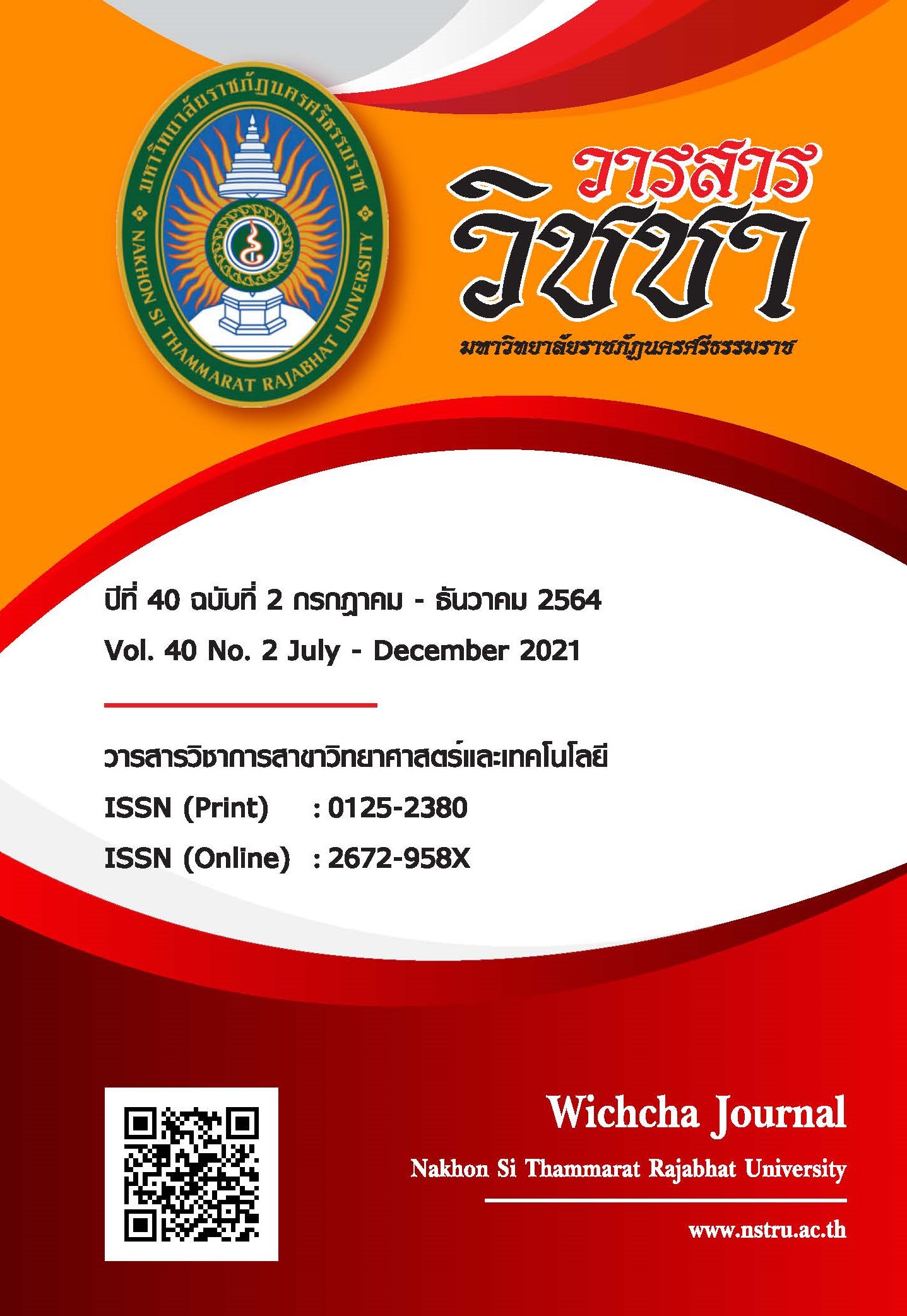Effects of Using Bio-extracts from Local Fruits and its Byproducts on the Coagulation Efficiency of Rubber Cup Lump ผลของการใช้น้ำหมักชีวภาพจากผลไม้และวัสดุเศษเหลือผลไม้ในท้องถิ่น ต่อการเพิ่มประสิทธิภาพการจับตัวของยางก้อนถ้วย
Main Article Content
Abstract
Nowadays, Thai farmers prefer to use chemicals to coagulate fresh rubber latex to produce rubber cup lumps in their fields. The acidic condition of the effluent deteriorates the rubber plants and may cause tapping panel dryness. In addition, the acid used can irritate hands or exposed skin and pollute the environment. Based on these problems, this research aimed to develop a bio-based rubber coagulant to produce rubber cup lumps using acids from local vegetable and fruit bio-extracts. A completely randomized design was used to study the effects of the addition of 6 coagulants, namely 3% formic acid, 3% sulfuric acid, 3% acetic acid, bio-extracts from lime peels, ripe bananas, and pineapple on the precipitation of rubber for 24 hours. The results showed that there was a statistical difference in the coagulation time of the rubber cup lumps between the 6 coagulants (p < 0.05). The rubber latex coagulation with sulfuric acid was the fastest, taking 33 minutes, but the rubber cup lump had a dry weight, and its coagulation efficiency was only 87.64%. When the results of the 3 bio-extracts were compared, it was found that the lime peel extract had the fastest latex coagulation time of 235 minutes, followed by ripe banana and pineapple with 466 and 467 minutes, respectively, with no significant difference between the fresh weight and the dry weight (p > 0.05), but the ripe banana bio-extract had the highest rubber coagulation efficiency of 99.61%, followed by the pineapple and the lime peel bio-extracts with 95.56% and 95.56%, respectively. The results of the acidity test showed that 3% sulfuric acid had the highest acidity value, with an initial pH of 0.71 and a serum of 0.97. When all 3 types of bio-extracts were used, the acidity was lower with a serum pH of 4.11-4.97. When the lime peel bio-extract, which had the fastest coagulation time, was soaked with rambutan peel for 2 weeks before use, it was found that the average coagulation time of the rubber cup lump was decreased from 235 minutes to 35 minutes and the coagulation efficiency increased from 95.56 to 100%. In addition, the pH of the serum or effluent after settling was low (pH 5.15) compared to sulfuric acid (pH 0.71), which was beneficial to the rubber trees, did not cause skin irritation, and did not acidify the soil.
Article Details
เนื้อหาและข้อมูลในบทความที่ลงตีพิมพ์ในวารสารวิชชา มหาวิทยาลัยราชภัฏนครศรีธรรมราช ถือเป็นข้อคิดเห็นและความรับผิดชอบของผู้เขียนบทความโดยตรง ซึ่งกองบรรณาธิการวารสารไม่จำเป็นต้องเห็นด้วยหรือร่วมรับผิดชอบใด ๆ
บทความ ข้อมูล เนื้อหา รูปภาพ ฯลฯ ที่ได้รับการตีพิมพ์ในวารสารวิชชา มหาวิทยาลัยราชภัฏนครศรีธรรมราช ถือเป็นลิขสิทธ์ของวารสารวิชชา มหาวิทยาลัยราชภัฏนครศรีธรรมราช หากบุคคลหรือหน่วยงานใดต้องการนำข้อมูลทั้งหมดหรือส่วนหนึ่งส่วนใดไปเผยแพร่ต่อหรือเพื่อการกระทำการใด ๆ จะต้องได้รับอนุญาตเป็นลายลักษณ์อักษรจากวารสารวิชชา มหาวิทยาลัยราชภัฏนครศรีธรรมราชก่อนเท่านั้น
The content and information in the article published in Wichcha journal Nakhon Si Thammarat Rajabhat University, It is the opinion and responsibility of the author of the article. The editorial journals do not need to agree. Or share any responsibility.
References
กองการยาง. (2563). สถิติยางประเทศไทย. สืบค้นเมื่อ 12 สิงหาคม 2564, จาก: https://www.doa.go.th/rc/suratthani/wp.
จันจิรา พ่วงทอง และอธิวีณ์ แดงกนิษฐ์. (2563). สถานการณ์ยางพาราปี 2562 และแนวโน้มปี 2563. วารสารยางพารา ฉบับอิเล็กทรอนิกส์, 41, 6-39.
ชัยวุฒิ วัดจัง เสาวลักษณ์ บุญยอด และประสิทธิ กาญจนา. (2561). การใช้ประโยชน์น้ำทิ้งจากการจับตัวแผ่นยางดิบสำหรับการผลิตยางก้อนถ้วย. Science and Technology RMUTT Journal, 8(2), 31-34.
ณัชชารีย์ ทวีหิรัญรัฐกิจ เปรมกมล ปิยะทัต และสุมาลี จิระจรัส. (2561). ความสัมพันธ์ของปัจจัยส่วนบุคคลที่ส่งผลต่อสภาพการผลิตยางก้อนถ้วยของสมาชิกสหกรณ์การเกษตรปฏิรูปที่ดินท่าแซะ จำกัด อำเภอท่าฉาง จังหวัดสุราษฎร์ธานี. วารสารวิทยาการจัดการ, 5(2), 205-231.
เบญจวรรณ คำศรี และอรทัย ชวาลภาฤทธิ์. (2555). การผลิตน้ำหมักชีวภาพที่ใช้ตะกอนสลัดจ์เป็นวัสดุหมักร่วม. ใน การประชุมวิชาการแห่งชาติมหาวิทยาลัยเกษตรศาสตร์ วิทยาเขตกำแพงแสน ครั้งที่ 9 (หน้า 461-467). นครปฐม: มหาวิทยาลัยเกษตรศาสตร์.
ปรีดิ์เปรม ทัศนกุล. (2558). หยุดการใช้กรดซัลฟิวริกในการจับตัวยาง. วารสารยางพารา, 36(3), 14-18.
ปรีดิ์เปรม ทัศนกุล. (2563). สมบัติพื้นฐานของน้ำยางสดและยางแผ่นรมควันที่สอดรับกับความต้องการของผู้ประกอบการ. วารสารยางพารา ฉบับอิเล็กทรอนิกส์, 41, 40-46.
พัชรี หลุ่งหม่าน จีรนันท์ กล่อมนรา แก้วรักษา และจาตุรนต์ ทิพย์วงศ์. (2560). การประยุกต์ใช้สถิติเพื่อการออกแบบสภาวะที่เหมาะสมในการหมักกรดอินทรีย์จากผลตะลิงปลิงโดย Zygosaccharomyces rouxii TISTR 5044 สำหรับทำยางก้อนถ้วย. วารสารวิทยาศาสตร์บูรพา. 22(3), 581-595.
ภัสจนันท์ หิรัญ อรพิน เกิดชูชื่น และณัฏฐา เลาหกุลจิตต์. (2552). ประสิทธิภาพของสารสกัดจากมะนาว มะกรูดและส้มโอในการยับยั้งเชื้อจุลินทรีย์. วารสารวิทยาศาสตร์เกษตร, 40(2 พิเศษ), 91-94.
ไมซาตุลอักมาล ท่าดะ อรวรรณ ทิพย์มณี และอาอีเซาะส์ เบ็ญหาวัน. (2560). การรักษาสภาพน้ำยางด้วยน้ำขี้เถ้าและการจับตัวของน้ำยางด้วยน้ำมะพร้าวหมัก. ใน รายงานการนำเสนอผลงานวิจัยระดับชาติ ด้านวิทยาศาสตร์ และสังคมศาสตร์: ราชภัฏวิชาการ. มหาวิทยาลัยราชภัฏนครศรีธรรมราช (หน้า 212-217). นครศรีธรรมราช: มหาวิทยาลัยราชภัฏนครศรีธรรมราช.
สถาบันวิจัยยาง. (2536). น้ำยาง. สืบค้นเมื่อ 21 มีนาคม 2561, จาก: http://pnpandbest.com/rubber/pnp_book04.html.
สายสมร ลำลอง และสมนภา คำนัน. (2557). การใช้น้ำหมักชีวภาพเปลือกสับปะรดผสมใบเตยเป็นสารจับตัวยางธรรมชาติ. วารสารวิทยาศาสตร์และเทคโนโลยี มหาวิทยาลัยอุบลราชธานี, 16(2), 55-62.
สำนักงานตลาดกลางยางพาราหนองคาย. (2559). ยางก้อนถ้วย. สืบค้นเมื่อ 25 มิถุนายน 2563, จาก: https://goo.gl/NGFoNP.
สุจินต์ แม้นเหมือน. (2556). อนาคตยางพารากับประชาคมเศรษฐกิจอาเซียน. วารสารยางพารา, 34(1), 7-16.
ศรัณญภัส รักศีล เชิดศักดิ์ เกื้อรักษ์ และรสวันต์ อินทรศิริสวัสดิ์. (2563). ความต้องการการทำวนเกษตรในสวนยางพาราเชิงเดี่ยวหลังเปิดกรีดของเกษตรกรพื้นที่ต้นน้ำ คลองป่าพะยอม-คลองท่าแนะ จังหวัดพัทลุง. วารสารวิชชา มหาวิทยาลัยราชภัฏนครศรีธรรมราช, 39(2), 72-86.
อมรเดช พุทธิพิพัฒน์ขจร และอมรฤทธิ์ พุทธิพิพัฒน์ขจร. (2561). การหาปริมาณเนื้อยางแห้งของยางก้อนถ้วยด้วยวิธีเนียร์อินฟราเรดสเปกโทรสโกปี. วารสารวิทยาศาสตร์และเทคโนโลยี, 26(4), 694-704.
Cheok, C.Y., Adzahan, N.M., Rahman, R.A., Zainal Abedin, N.H., Hussain, N., Sulaiman, R. and Chong, G.H. (2018). Current trends of tropical fruit waste utilization. Critical Reviews in Food Science and Nutrition, 58(3), 335-361.
Chutia, M., Deka, P., Pathak, M.G. and Sarma, T.C. (2009). Antifungal activity and chemical composition of Citrus reticulata Blanco essential oil against phytopathogens from North East India. LWT- Food Science and Technology, 42(3), 777-780.
Dinesh Fernando, M.G. and Kaluarachchi, C.I. (2012). Death due to adult respiratory distress syndrome following assault with rubber acid could it have been averted. Sri Lanka Journal of Forensic Medicine. Science and Law, 3(1), 13-15.
Kaya, M., Sousa, A.G., Crépeau, M.J., Sørensen, S.O. and Ralet M.C. (2014). Characterization of citrus pectin samples extracted under different conditions: influence of acid type and pH of extraction. Annals of Botany, 114(6), 1319-1326.
Mahmood, K., Fazilah, A., Yang, T.A., Sulaiman, S. and Kamilah, H. (2018). Valorization of rambutan (Nephelium lappaceum) by-products: Food and non-food perspectives. International Food Research Journal, 25(3), 890-902.
Normah, O. and Hasnah, K.A.K. (2000). Pectin content of selected local fruit by-products. Journal of Tropical Agriculture and Food Science, 28(2), 195-201.
Pereira, P.H.F., Oliveira, T.Í.S., Rosa, M.F., Cavalcante, F.L., Moates, G.K., Wellner, N., Waldron, K.W. and Azeredo, H.M.C. (2016). Pectin extraction from pomegranate peels with citric acid. International Journal of Biological Macromolecules, 88, 373-379.
Shaha, R.K., Nayagi, Y., Punichelvana, A.P. and Afandi, A. (2013). Optimized extraction condition and characterization of pectin from Kaffir Lime (Citrus hystrix). Research Journal of Agriculture and Forestry Sciences, 1(2), 1-11.
Tekasakul, P. and Tekasakul, S. (2006). Environmental problems related to natural rubber production in Thailand. Journal Aerosol Research, 21(2), 122-129.
Yeoh S., Shi, J., T.A.G. and Langrish, T.A.G. (2008). Comparisons between different techniques for water-based extraction of pectin from orange peels. Desalination, 218(1-3), 229-237.


